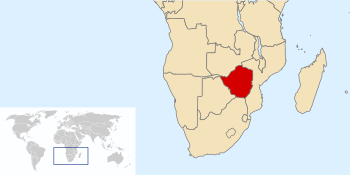Rhodesia facts for kids
Quick facts for kids
Rhodesia
|
|||||||||
|---|---|---|---|---|---|---|---|---|---|
| 1965–1979 | |||||||||
|
|
|||||||||
|
Anthem: "Rise O Voices of Rhodesia" (from 1974)
|
|||||||||
 |
|||||||||
| Status | Unrecognized state | ||||||||
| Capital | Salisbury | ||||||||
| Common languages | English | ||||||||
| Government | Various | ||||||||
| President¹ | |||||||||
|
• 1970–1975
|
Clifford Dupont | ||||||||
|
• 1976–1978
|
John Wrathall | ||||||||
| Prime minister | |||||||||
|
• 1965–1979
|
Ian Smith | ||||||||
| Historical era | Cold War | ||||||||
|
• Independence (UDI)
|
11 November 1965 | ||||||||
|
• Republic declared
|
2 March 1970 | ||||||||
|
• Zimbabwe-Rhodesia
|
1 June 1979 | ||||||||
|
• Zimbabwe
|
17 April 1980 | ||||||||
| Area | |||||||||
| 1978 | 390,580 km2 (150,800 sq mi) | ||||||||
| Population | |||||||||
|
• 1978
|
6930000 | ||||||||
| Currency | Rhodesian pound (until 1970) Rhodesian dollar (from 1970) |
||||||||
|
|||||||||
|
¹ The government recognised Queen Elizabeth II as the official Head of State from 1965 to 1970. The highest official of Rhodesia held the title "Officer Administering the Government" (OAtG) as he acted in lieu of the official Governor, who remained at his post but was ignored. After Rhodesia became a republic in March 1970 the president replaced the OAtG as the highest official, and the Governor returned to London.
|
|||||||||
Rhodesia was a country in southern Africa that existed from 1965 to 1979. It was not recognized by most other countries. Today, this area is known as Zimbabwe.
Rhodesia was a landlocked country, meaning it had no coastline. It shared borders with South Africa to the south, Botswana to the southwest, Zambia to the northwest, and Mozambique to the east.
Contents
How Rhodesia Began
From Company Rule to Self-Government
In the late 1800s, a British company led by Cecil Rhodes took control of the land that would become Rhodesia. This company ruled the area until the early 1920s.
In 1923, the company's rule ended. The area, then called Southern Rhodesia, gained the ability to govern itself. It set up its own law-making body, called a legislature.
From 1953 to 1963, Southern Rhodesia was part of a larger group called the Federation of Rhodesia and Nyasaland. This federation also included Northern Rhodesia (now Zambia) and Nyasaland (now Malawi).
Declaring Independence
In the early 1960s, many African countries were gaining independence from European rule. This made some of the white people in Rhodesia worried. They wanted to keep their power and delay a government where the black majority would rule.
So, on November 11, 1965, Rhodesia's government, which was mostly white, declared its own independence from the United Kingdom. This was called the Unilateral Declaration of Independence (UDI). The United Kingdom did not agree with this.
At first, Rhodesia wanted to be an independent part of the Commonwealth of Nations. But in 1970, it changed and became a republic.
The Rhodesian Bush War
Conflict and Change
After the UDI, a conflict known as the Rhodesian Bush War started. The Rhodesian government fought against two main African nationalist groups: ZANU and ZAPU. These groups wanted a government where everyone had equal rights.
The war grew more intense in the 1970s. Because of this, Rhodesia's leader, Ian Smith, agreed in 1978 to move towards a government that included all races.
Towards a New Zimbabwe
A temporary government was formed, led by Ian Smith and Abel Muzorewa. However, this government did not satisfy international critics or stop the fighting.
By December 1979, Muzorewa became the Prime Minister. He reached an agreement with the nationalist groups. This agreement allowed Rhodesia to briefly return to being a British colony. This was a step towards new elections where everyone could vote.
Finally, in April 1980, Rhodesia gained full international recognition as an independent country. It was renamed the Republic of Zimbabwe.
Life in Rhodesia
Cities and People
Rhodesia's biggest cities were its capital, Salisbury, and Bulawayo.
The white population in Rhodesia grew to almost 300,000 people. They had most of the political and economic power. However, they made up less than 8% of the total population.
Economy and Government
Rhodesia's economy relied heavily on farming, manufacturing, and mining. Its main exports were chromium, tobacco, and steel.
Other countries placed sanctions on Rhodesia. This meant they stopped trading with Rhodesia, which put increasing pressure on the country's economy.
Rhodesia had a law-making body called the Legislative Assembly. Most of its members were white, with a few seats set aside for black members.
After Rhodesia became a republic in 1970, this assembly was replaced. A new Parliament was created with two parts: a House of Assembly and a Senate. The country had a President who was the ceremonial head of state, and a Prime Minister who led the government.
Images for kids
-
Ian Smith signing the Unilateral Declaration of Independence
-
Signing of the Rhodesian Internal Settlement (from left: Bishop Abel Muzorewa, Ian Smith, Jeremiah Chirau and Ndabaningi Sithole)
See also
 In Spanish: República de Rodesia para niños
In Spanish: República de Rodesia para niños






